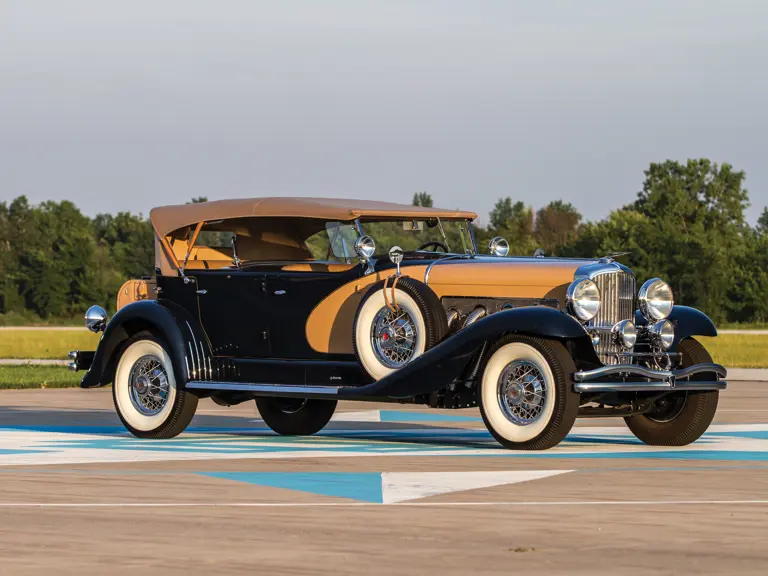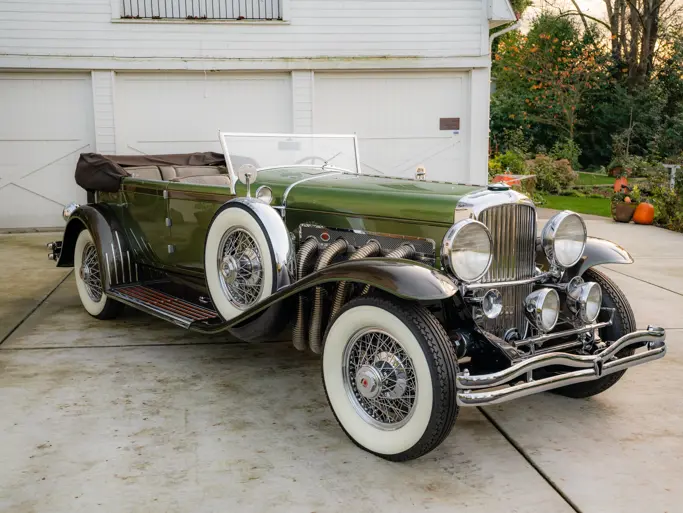
1935 Duesenberg Model SJ 'Sweep Panel' Dual-Cowl Phaeton in the style of LaGrande
{{lr.item.text}}
$858,000 USD | Sold
{{bidding.lot.reserveStatusFormatted}}
- From the Collection of Jerry Shaw
- The company car of Duesenberg president Lucius B. Manning
- Formerly the property of the Fischer family
- Original engine and chassis
Coachwork in the Style of LaGrande
Chassis no. 2592
Engine no. J-562
420-cid, 320-hp, supercharged DOHC inline eight-cylinder engine, three-speed manual transmission, beam type front and live rear axles with semi-elliptic leaf springs, and vacuum-assisted four-wheel hydraulic drum brakes. Wheelbase: 153.5-inches
While scores of superlative automobiles have graced the world since the dawn of the motor car, precious few have generated new words for our lexicon. Today, the Duesenberg Model J, affectionately nicknamed the “Duesey,” continues to represent anything truly great or grand. Bankrolled by E.L. Cord and designed from the outset to be the world’s finest car, the Model J debuted at the New York Auto Salon on December 1, 1928, where its launch dominated newspaper headlines and halted trading on the floor of the New York Stock Exchange. In short, from introduction to the present, the Model J marks the crowning achievement of the Classic Era.
While brothers Fred and Augie Duesenberg are remembered best for creating the immortal Model J, their reputations had already been forged and tested in the heat of competition. As a result, their highly advanced racing technology found its way into all their road cars, with specifications making competitors’ offerings dated in comparison and remaining surprisingly current even by today’s standards. In particular and most obvious, the Model J’s dual-overhead cam inline eight-cylinder engine, a visually impressive 420-cubic inch unit, developed 265-hp in normally aspirated form and featured a free-breathing, four-valve cylinder head.
Despite the Model J’s massive proportions, with its short-wheelbase chassis measuring 142½-inches and the long one, 153½-inches, extensive use of lightweight heat-treated aluminum parts and components provided significant weight savings and preserved the car’s commanding performance.
In the Classic Era, it wasn’t uncommon for an owner to have a favorite coachbuilt body, which would be reconditioned and moved to a new chassis every few years, rather than buying an entire new automobile at tremendous cost. Duesenberg President Lucius B. Manning was no exception, and had at his disposal a “sweep panel” Dual-Cowl Phaeton, designed by Gordon Buehrig and built under the “LaGrande” label by Union City Body Company.
Manning used this body on four different Model J Duesenberg chassis, of which this car, chassis no. 2592 and engine no. J-562, was one. The car was driven by Manning in Chicago for about a year, demonstrating the power of the Duesenberg, during which time it was appropriately upgraded with a supercharger to full “SJ” specification. When an order for a new Duesenberg chassis came through, Manning allowed the chassis of this car to be taken for the sale, and it was rebodied as a Willoughby Berline.
Years later, the Willoughby body was removed, and the chassis sold to well-known collector Hubert Fischer of Wisconsin. Fischer had the original LaGrande Dual-Cowl Phaeton body recreated by respected craftsman Harold Orchard of California, whose work was extremely highly regarded. More recently the recipient of an engine rebuild and the proper installation of a reproduction supercharger by well-known Duesenberg technician Brian Joseph’s facility, and today is exactly as it appeared when enjoyed by Mr. Manning.
With exhaustive work taken to make it just as it was when Duesenberg’s top man enjoyed it on a daily basis, this striking Duesenberg would be no less enjoyable to drive and show today.


 | Auburn, Indiana
| Auburn, Indiana


